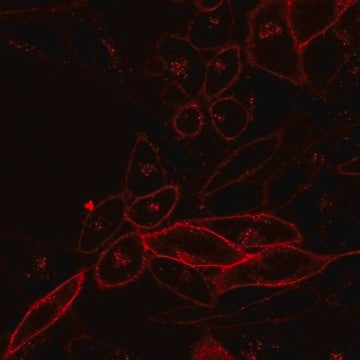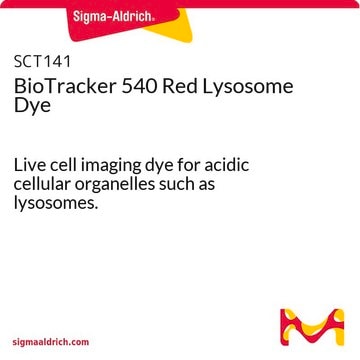This product has not been tested for an increase in fluorescence intensity with chromosome condensation.
SCT120
BioTracker 488 Green Nuclear Dye
Live cell imaging green nuclear staining dye with greater photostability than traditional blue fluorescent nuclear stains such as DAPI and Hoechst 33342.
Synonym(s):
Live cell imaging probe, Live cell nuclear imaging probe
Select a Size
£363.00
In StockDetails
Select a Size
About This Item
£363.00
In StockDetails
Recommended Products
technique(s)
cell based assay: suitable
detection method
fluorometric
shipped in
ambient
General description
The BioTracker 488 Green Nuclear Dye is a cell-membrane permeable green fluorescent DNA dye that specifically stains nuclei in live or fixed cells. It has excellent specificity for DNA without the need for a wash step, and it has low toxicity for live cell imaging. The dye is supplied with a vial of verapamil, an efflux pump inhibitor that may improve probe retention and live cell staining in certain cell types.
Note: BioTracker Nuclear Dyes also shows blue fluorescence in the DAPI channel, and may not be suitable for multicolor imaging with blue probes.
Spectral Properties
Absorbance: 500nm
Emission: 515nm
Application
Cell Imaging
Live Cell Dye
Components
2) 1 vial of 100µL Verapamil HCL (100mM in DMSO) (CS224592)
Quality
Absorbance: 500nm
Emission: 515nm
Physical form
Storage and Stability
Note: Centrifuge vial briefly to collect contents at bottom of vial before opening.
Disclaimer
Signal Word
Warning
Hazard Statements
Precautionary Statements
Hazard Classifications
Acute Tox. 4 Oral - Aquatic Chronic 2
Storage Class Code
10 - Combustible liquids
Certificates of Analysis (COA)
Search for Certificates of Analysis (COA) by entering the products Lot/Batch Number. Lot and Batch Numbers can be found on a product’s label following the words ‘Lot’ or ‘Batch’.
Already Own This Product?
Find documentation for the products that you have recently purchased in the Document Library.
Customers Also Viewed
-
Does the fluorescence intensity increase by chromosome condensation similarly to DAPI or Hoechst?
1 answer-
Helpful?
-
-
Is there any toxicity data available for extended (>48h) live cell staining?
1 answer-
The dye with verapamil showed no obvious toxicity in MCF-7 cells over the course of 72 hours. It may be different for different cell lines and different experimental conditions.
Helpful?
-
-
Is it possible to use SCT120 BioTracker 488 Green Nuclear Dye and PKH26 Red Fluorescent Cell Linker for in vivo applications, and what is their stability duration?
1 answer-
The PKH series of dyes are designed for membrane labeling and can be used to track cells through several divisions. The intensity of the dye decreases by half with each cell division, so the duration of visibility will depend on the cell division rate of the specific cell type.
Regarding SCT120 nuclear dye, there is limited information about the viability of cells after staining or the photostability of the dye once the cells have been stained.
Currently, there is no available information on the compatibility or effects of using SCT120 in conjunction with PKH26GL for dual staining of cells.
Helpful?
-
-
How can I optimize staining using SCT120?
1 answer-
The recommended protocol for using SCT120 is as follows:
1. Dilute the BioTracker™ Nuclear Dye from its 1000X stock solution to a working concentration of 1X in cell culture medium. To achieve this, one could add 1 µL of dye to 1 mL of culture medium. It is important to note that the optimal concentration of the probe may vary depending on the cell type. Optionally, verapamil can be included in the staining solution to enhance probe retention in live cells. The ideal concentration of verapamil will likely be different across cell types, and it is suggested to test concentrations ranging from 10-100 µM.
2. Discard the culture medium from the cells and replace it with the diluted BioTracker™ Nuclear Dye solution. Incubate the cells at 37°C for a minimum of 10 minutes.
To optimize staining, consider the following adjustments:
• Probe Dilution: Although the standard dilution is 1:1000, experimenting with other dilutions such as 1:500 or 1:750 could be beneficial. Observe the results and, if necessary, test additional dilutions to find the most effective concentration.
• Verapamil Concentration: The suggested range for verapamil is between 10 to 100 µM. Trial with two or three different dilutions within this spectrum may help to refine the staining process.
• Incubation Time: Initially, a 10-minute incubation is recommended. However, extending this period to 20, 40, or even 60 minutes at 37°C could improve staining results. If positive changes are noted, further experimentation with the duration may be warranted to optimize the staining signal.
It is vital to only change one variable at a time during these optimizations. Altering multiple factors simultaneously, such as the dye dilution, verapamil concentration, and incubation time, would make it difficult to identify which specific change led to any observed improvements. Additionally, checking cell viability before staining is advisable. Using Trypan Blue to determine cell viability might provide insights into the overall health and suitability of the cells for staining.
Helpful?
-
-
Will SCT120, BioTracker 488 Green Nuclear Dye SCT work with the FITC channel?
Will SCT120, BioTracker 488 Green Nuclear Dye SCT work with the FITC channel?
1 answer-
Yes, for SCT120 we do recommend analyzing the cells using the FITC channel.
Please refer to the product's data sheet, found in the DOCUMENTATION section of the Product Detail Page: https://www.sigmaaldrich.com/product/mm/sct120#product-documentation
Helpful?
-
-
Could you please provide the chemical structure and formula for BIOTRACKER 488 GREEN NUCLEAR DYE, if available?
1 answer-
This information is considered proprietary.
Helpful?
-
-
Hi I was wondering if this stain would work in a 100% alcoholic liquid, or whether it requires protons to fluoresce?
1 answer-
The dye has not been validated for DNA binding under 100% alcoholic liquid. It does not require protons to fluoresce.
Helpful?
-
Active Filters
Our team of scientists has experience in all areas of research including Life Science, Material Science, Chemical Synthesis, Chromatography, Analytical and many others.
Contact Technical Service


















